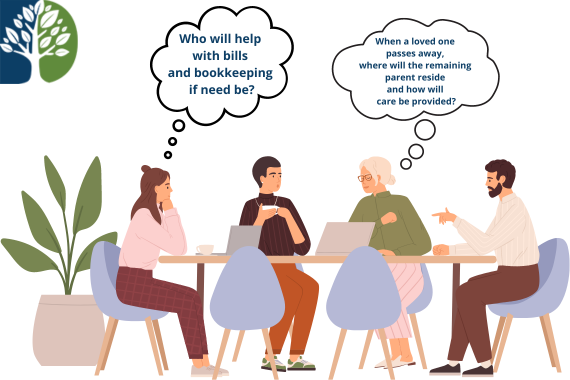As new parents, more than anything we want to raise, happy, healthy children. This is the most important and most difficult job we will ever have. It often feels like an experiment as we try different things, not knowing how it will play out 10, 15 or 20 years later. What we know is that lasting happiness comes from a deeper sense of purpose, pride, identity and satisfaction with oneself. Helping our children develop these things within themselves is hard and takes thoughtful work. It means giving them the freedom to fail and make hard choices.
There is a story that comes up frequently in books about parenting. It tells how eagles build their nests when preparing for their young.
“First the Father collects rocks and branches, often with thorns attached to create an underlayer. On top of this he builds up a softer pad made of grasses and feathers. When the baby eagles are born, they have a chance to mature in comfort, protected from predators. While living in the nest, they are helpless, weak, and passive. Then there comes a time when they begin to outgrow the confines of the nest but don’t know yet how to fly, let alone hunt down their own food.
It’s at this point the mother eagle begins to strip down the soft padding that cushions the nest. As the eagles teeter on the edge, afraid to launch into the air for the first time, she is busy exposing the thorns and rocks and sharp branches. When the baby eagles fall back, they no longer find the familiar and the comfortable embracing them. In this way they are urged to literally take flight.1”
As parents, we need to take small steps to prepare kids for flight, and we may have to urge them to try things, even when they don’t feel ready. The opposite way to look at this is that those eagle parents knew their young were ready to fly because they had been preparing them for the day when the soft padding would be removed.
Preparing our kids to have a positive money mindset—confidence in how to earn it on their own, make good decisions with it, overcome setbacks and be motivated toward a goal—will make an enormous impact on their lasting happiness.
Today, money remains a top stressor for Americans, according the American Psychological Associations Stress in America™ survey. The 2018 survey found that 81 percent of people in Generation Z (those between ages 15 and 21) reported that money was a significant source of stress. The goal of this article is to share ideas about how we can create lasting happiness for our children and improve their money skills so that when they become an adult they don’t just fly; they soar like eagles.
Lead by Example
We pass along a blueprint to our children of how to live a happy and healthy life by the example we set. This includes our relationship with money (do we have a scarcity or abundance mindset), how we use money and the healthy relationship between money and happiness. If your kids see you stressed out every time you pay bills or when the holidays come around, they are going to develop a similar mindset. On the other hand, if you are talking about an expensive vacation, you could say “That would be so much fun. Let’s create a plan to save enough to do that. How do you think we could earn more to get there faster? Are there some things we could do without?” Then you are showing your children that you are in the driver’s seat, and that some expensive things are worth saving for.
Years ago, my sister and her kids wanted to get chickens. She could have just bought a coop; I am sure she could afford it. Instead she labeled a clear mason jar chicken coop and set it on the counter. Both she and her kids (ages 8 and 9 at the time) contributed money they earned. They would count the money weekly to see how much more they needed. The day they got those chickens and that coop was momentous. The act of saving taught them delayed gratification, that they could make a difference with their contributions, and about the decision-making process of giving up one thing for another.
Let Them Make Mistakes
The lessons we remember are typically because we have felt pain from having to give up something for something else. As much as we would like to just share our wisdom, most of the time our kids need to learn by doing to truly understand. A colleague of mine shared one of his first money experiences at a conference we attended. He and his siblings would go to a big fair for a weekend every year. His parents would give them each a certain amount of money to spend on games and fun while they were there. He described how the first year they went he spent all of his money in the first hour. He cried and cried and begged his parents to reconsider and give him a second chance, but they did not back down. He never made that mistake again. Youth is the time for kids to make small mistakes, so they will not make big, more consequential ones later.
Teach them to Earn
Kids need to know where money comes from and build confidence in their ability to earn it. This contributes to building confidence and a sense of self. Money should be earned for providing value. You can explain the different jobs people do to earn money. Growing up, my needs were met, but there was not a lot of extra money for wants. This incentivized me to get creative at providing the things I wanted, from washing cars and collecting cans for recycling at age 9, to babysitting and working at a restaurant. I always had money for a movie, clothes I wanted, or for a trip. Though there were times when money was tight, I knew I could make more. Learning how to be proactive about earning money made me feel in control, not a victim.
When my oldest daughter was about 5 or 6, she had her first experience earning money. My husband’s family had a farm with a three-story barn. The town had a town-wide yard sale every April, and that year we told our daughters they could sell lemonade. They were at the stage where they were asking for things at the store, and we told them it was time for them to earn their own money. They helped make the lemonade and a sign with the price. It was a hot day, and there must have been 100 people that stopped by our barn sale table. My daughter was bothered few people were buying lemonade, so I told her “You have to go and ask them if they would like some lemonade.” She left me and her younger sister at the lemonade table and overcame her shyness to ask people if they would like lemonade. We sold out in no time. On the way home I asked her what she liked best, and she said, “making money”.
The next year we added cookies alongside the lemonade. I also raised the stakes a little. I explained that they would have to pay me back for the supplies, but they could keep everything else. I explained the difference between sales, expenses and profit. They understood this. We talked about buying supplies in bulk to reduce the cost, and I brought them with me to the store to compare costs of the items. They split the profit. This went on for years until the farm was eventually sold. Over the years, my children took our lessons to heart. I usually made the cookies, and so one year they decided that we should split the profits in thirds, since I had contributed my time. This was a big step as managing money in adulthood is also about managing relationships between people. The annual yard sale was something we looked forward to for many years.
It is difficult for busy families to prioritize making time for their teenagers to have a part-time job, especially when it includes driving them there. Families also worry about work getting in the way of their children’s grades and extracurricular activities. One solution is a summer job. A summer job will give your child the opportunity to build self-confidence, experience increased responsibility, improve communication skills and provide their own money to manage.
Allowance or Commission?
There is an ongoing debate about whether to pay your children an allowance, or a commission for each job they do. I am not convinced there is a right and wrong here. Dave Ramsey says pay commission, and Ron Lieber, author of “The Opposite of Spoiled; Raising Kids Who are Grounded, Generous, and Smart about Money” thinks that paying a commission makes work the primary focus, not the money. Honestly, I could not keep up with tracking a done chores list. It was too much work. I also believe we all live in the same house and everyone should help with the household chores. I didn’t want to tie their compensation to a job. You may feel differently and that is ok.
My kids have always been responsible for something: emptying the dishwasher, setting the table, helping cook dinner, etc… Our goal for paying them allowance was to get them to stop asking us for stuff when we were out and help them become more responsible with money. We knew it would develop savvy shopping skills and teach delayed gratification through saving for something meaningful. We started paying them weekly $1 per year of their age when they were ages 5 and 7. (Note: this caused issues when our younger daughter did more than her sister.) This amount covered everything they needed and wanted at the time. We labeled three clear mason jars SAVE, SPEND & GIVE and would have them split their allowance between the jars. (I didn’t always have cash, and sometimes had to pay them multiple weeks at a time – it is ok not to be perfect)
Traditionally GIVE has been for donating to nonprofits, but young kids sometimes have trouble connecting with a nonprofit unless the family is involved. In my opinion, giving is also about the joy of doing something for others. When they are little, I think using the GIVE money to buy gifts for family members or friends is also valuable. The joy they will feel to save for something a friend wants and be able to earn it all on their own is priceless and a great lesson in selflessness. We also offered jobs to earn more. We live on a farm, so these included cleaning the chicken coop and mowing the lawn.
Now we require them to do some of these things, but they still get paid separately, above and beyond their allowance. As they have grown, we have increased their allowance and responsibility. Our girls have done their own laundry since they were about 10. It started with them just putting the laundry away when they were little, then folding and putting it away, and then I taught them to use the washer and dryer and they have been independent since. As they got older and more capable, they also had increased responsibilities at dinnertime. They are now in charge of planning a meal, down to making the grocery list. Now they can make an entire meal on their own for the family. We all take turns cooking and cleaning up. The best part of this is how proud they feel. Their friends are always impressed by what they can cook, and they sometimes surprise themselves with how well a meal comes out. (Tip: When our youngest was 11 we started getting a home delivery meal service called Home Chef for two meals a week that had all of the ingredients and clear instructions. This saved me time on meal planning and the instructions increased their self-confidence to do it on their own. They graduated to planning a meal from scratch after this.)
Where to keep the Money – Bank, Jar, Wallet
I mentioned the SAVE, SPEND, GIVE jars above. The rule of thumb is a small clear container that can be filled easily when they are younger. Being able to fill it easily makes it more exciting for them. It can seem like forever if the container is too big. So, when do you get them a bank account? When their jars start filling up. You can open a savings accounts for kids at any age. You will need to be a joint owner. Banks don’t typically allow kids to have a checking account with a debit card until they are a teen. Credit Unions tend to have fewer fees and higher interest rates. Mine pays over 6% interest on balances up to $1,000. You may also want to consider matching their savings once they get to a certain amount that would be a stretch goal, like $50 or $100. For their spend money, it might be fun to make a wallet with them to decorate and keep their money in.
When they become teenagers, they will need access to a debit card to pay for gas and more of their own things. My daughter was 14 when we converted her account to a checking and savings account. She was a natural at managing her account online, transferring excess in her checking to her savings to earn more interest.
Teaching about Money by Age Click here to download a printable version of Teaching Money by Age
Ages 3-5
Main goals: Teach the concepts of working and finishing a job. Instill a sense of pride about a job well done and teach about spending (Saving is difficult to grasp this young).
Ideas to Implement:
- Talk to them about the value of coins and dollars.
- Give them simple jobs for $0.50 or $1 such as sweeping the floor and wiping the counters.Pay upon completion of the job. They need immediate gratification.
- Take them shopping to spend the money they earn. Let them handle the transaction and make all decisions.
- Let them help you at the grocery store. Give them $5 and ask them to pick snacks or fruit for the week. They will learn how to make trade-offs and notice what items cost.
Ages 6-13
Main goals: Teach the give/save/spend concept to instill the value of money and give them increased decision- making power in how their money is spent and education on earning more.
Ideas to Implement:
- Start the Give/Save/Spend Concept. Example: $5 pay = $1 Give, $2 Save, $2 Spend
- Give a weekly allowance – possibly a $1 per year of age. (Tip: Go to the bank and get $100 in $1 bills. At this age it is important to have money. As my kids got older, we did an automatic transfer into their account.)
- Increase responsibilities (Watering plants, walking the dog, emptying the dishwasher, cleaning windows, vacuuming, emptying the garbage cans)
- Set a goal for something to save up for. Money should be fun.
- Encourage them to use their own money for gifts for family members or special friends. You could also match their savings for a gift.
- Let them choose how to use their Spend money.
- Talk about how to be a smart shopper. Show them how to find things on sale and at discount stores.
- Open a savings account at the local bank.
- Give them spending money for vacation and let them choose how to spend it.
- Determine how much you would spend on back to school clothing. Give them the money and be clear about what they need to buy. Let them know they can keep any money left over. This will help them practice making decisions, like picking the expensive shoes over getting to keep what’s left. Show them that you can have a store hold an item for you and you can go back and get it later if you still really want it. (Ages 11-13)
- Explain what it means to be an entrepreneur. Are they interested in starting a teenage business?
- Buy them their first stock of a company they like or shop at. Explain the concept of owning a share and participating in the earnings of the company through dividends. (Age 11-13)
Ages 14+
Main goals: Give kids increasing responsibility for making and spending their money. Let them learn from their mistakes, don’t bail them out. Reinforce the relationship between money and value.
Ideas to Implement:
- Convert their bank account to a checking/savings
- If they have honed their skills, take the amount you normally spend on their clothes or entertainment and give it to them as a monthly amount in their bank account. Don’t question what they spend money on, but review it with them.
- Encourage them to get a part-time job if they want more spending money.
- Explain the concept of taxes, what they are used for and that they will come out of their paycheck.
- Explain what their costs are, even if you are paying for them. Maybe even stop to ask if they think it is worth the cost. What do their sports and activities cost? How much does camp cost?
- Consider having them help pay for large items, such as part of an expensive school trip, a car, or a special camp they want to attend.
- Help them understand the concept of spending money on things that you value. You may be someone who always buys used cars, but you spend your savings on exotic travel because you value exploring with your family. It’s not about being cheap.
- Understand the life energy value of money. You give up your time to make money for things. My daughter wanted a pair of shoes. When I asked her how many hours babysitting it would take to pay for them, she decided against it. It was for her to decide, not me.
- Consider opening a Roth IRA if they have earned income. Most kids will want to have their money available for college spending money, etc. You can tell them you will match any of their long-term savings by putting it in a Roth IRA for them or match their Roth Contribution.
- Begin teaching them about investing. Have them open a brokerage account (or do this in their Roth IRA) and buy a few stocks of companies they like with 25% of the money, then buy indexed funds with the remaining 75%. Track the volatility of them. Explain that an index fund owns hundreds or thousands of companies that you now own a piece of. Let them experience it increasing and decreasing in value.
- There is a debate on this, but as your child is determining what career to pursue, it may be important to have a conversation about how much it costs to support the lifestyle they are currently living. What is your mortgage, property taxes, utilities? How much do they need to earn to support a similar lifestyle? You don’t want them to become a teacher and expect to live like a Sales Executive. (Ages 16-18)
- Go through the costs of colleges with them and if they take out a loan, what those payments might look like.
Ages 18+
Main goals: Make sure your adult children have the knowledge, support and freedom to make wise financial decisions. Ensure an open dialogue about money, responsibility and independence.
Ideas to Implement:
- Set expectations of what you are going to help with, during college and after. Some parents pay for all of college, others pay for most and ensure their kids have a loan or pay for a semester so they are invested in their education. Explain what choice you are making and why.
- If you are going to give them a monthly allowance for their needs while they are at college, talk about what that should be used for. When it’s gone, it’s gone.
- If you are going to require them to hold a campus job to cover those expenses, or part of them, discuss how to balance school and work.
- Explain the concept of insurance to them and how it is used (to protect your savings in a worse- case scenario situation). If you are sending them to college with their own car, consider making them pay you back for the insurance.
- At this stage, they should already understand delayed gratification, have work experience, be used to saving and giving money-not just spending, know how to make a paycheck last and consider expenses beyond today.
Resources
Websites and Online Games for kids at various ages and resources for Parents too.
www.practicalmoneyskills.com: Tons of resources and games, including Financial Soccer and Football. Provided by Visa.
www.themint.org: More games and resources for kids, teens, parents and recent graduates.
www.kidsmathgamesonline.com: This is a math games website, but has a section for Money Games. You can try your hand at becoming an entrepreneur by opening a coffee shop or lemonade stand. These teach some great lessons about tradeoffs.
www.smckids.com: This is Warren Buffet’s Secret Millionaires Club. It is animated series that features Warren Buffett as a mentor to a group of entrepreneurial kids whose adventures lead them to encounter financial and business problems to solve. The program teaches the basics of good financial decision making and some of the basic lessons of starting a business.
www.moneyconfidentkids.com: Includes magazines and games for kids at different ages, educational guides for parents, as well as educators. Presented by T. Rowe Price
https://www.consumerfinance.gov/consumer-tools/money-as-you-grow/: The Consumer Financial Protection Bureau have created a resource that includes conversation starters and activities to improve your children’s money habits and attitudes.
President’s Advisory Council on Financial Capability 20 Things Kids Need to Know to Live Financially Smart Lives
Books for Young Children:
“The Berenstein Bears’ Trouble with Money” by Stan and Jan Berenstain (my favorite)
“Milton the Money Savvy Pup Brings Home the Bacon” by Jamie A. Bosse, CFP®, RFC®
Here is a link for more age-specific books.
Parenting Books About Kids & Money:
“The Opposite of Spoiled: Raising Kids Who Are Grounded, Generous, and Smart About Money” by Ron Lieber
“Raised Healthy Wealthy and Wise: Lessons from successful and grounded inheritors on how they got that way” by Coventry Edwards-Pitt
“Even if Your toes turn Purple: Raising Teenagers That Are Confident, Happy, and Stand Out” by Rich and Tim Christiansen (Rich is an entrepreneur that has raised his children to become entrepreneurs. His kids were even responsible for paying for their own vacations)
“Is Your Child a Money Master or Money Monster? Seven Habits of Highly Motivated Kids for Financial Success” by Sunny Lee
“Silver Spoon Kids: How Successful Parents Raise Responsible Children” by Eileen & Jon Gallo
“Smart Money Smart Kids: Raising the Next Generation to Win With Money” by Dave Ramsey and Rachel Cruze
“Kids, Wealth, and Consequences: Ensuring a Responsible Financial Future for the Next Generation” by Richard Morris
1. Excerpt from Raised Healthy, Wealthy & Wise by Coventry Edwards-Pitt






